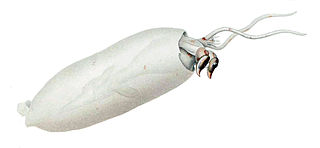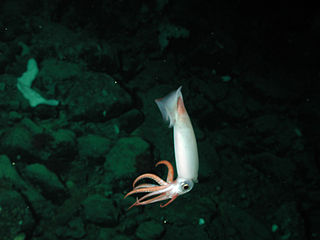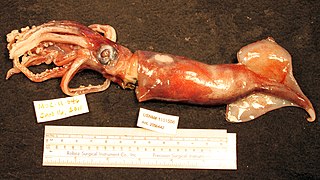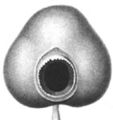
True squid are molluscs with an elongated soft body, large eyes, eight arms, and two tentacles in the superorder Decapodiformes, though many other molluscs within the broader Neocoleoidea are also called squid despite not strictly fitting these criteria. Like all other cephalopods, squid have a distinct head, bilateral symmetry, and a mantle. They are mainly soft-bodied, like octopuses, but have a small internal skeleton in the form of a rod-like gladius or pen, made of chitin.
The Chiroteuthidae are a family of deep-sea squid, generally small to medium in size, rather soft and gelatinous, and slow moving. They are found in most temperate and tropical oceans, but are known primarily from the North Atlantic, North Pacific, and Indo-Pacific. The family is represented by approximately 12 species and four subspecies in four genera, two of which are monotypic. They are sometimes known collectively as whip-lash squid, but this common name is also applied to the Mastigoteuthidae, which are sometimes treated as a subfamily (Mastigoteuthinae) of Chiroteuthidae.

The Mastigoteuthidae, also known as whip-lash squid, are a family of small deep-sea squid. Approximately 20 known species in six genera are represented, with members found in both the mesopelagic and bathypelagic zone of most oceans. Originally described by Verill in 1881, it was later lowered by Chun (1920) to a subfamily (Mastigoteuthinae) of the Chiroteuthidae. However, Roper et al. (1969) raised it back to the family level, and this has not been changed since. The taxonomy of this family is extremely unstable, and there have been at times one genus, two genera and four subgenera(Salcedo-Vargas & Okutani, 1994), two genera and several 'groups', five genera and one species with an uncertain placement, or six genera.

Doryteuthis plei, also known as the slender inshore squid or arrow squid, is a medium-sized squid belonging to the family Loliginidae. It occurs abundantly in coastal waters of the Atlantic Ocean, from Argentina northward to North Carolina.

Bathothauma lyromma, the lyre cranch squid, is a highly modified species of glass squid from the family Cranchiidae with a distribution which encompasses most of the world's oceans from the tropics to high latitudes.

Sandalops melancholicus, the sandal-eyed squid or melancholy cranch squid, is a small species of glass squid. It is known to reach a mantle length of 11 cm. It is distributed in the tropical and subtropical oceans around the world. It is the only species in the genus Sandalops but some authorities suggest that this may be a species complex rather than a monotypic genus.

Liocranchia is a genus of glass squid from the family Cranchiidae. They are moderate-sized with a long, spindle-shaped mantle which tapers to a point at the rear and they can attain mantle lengths of 250 mm. The species in Liocranchia have a cosmopolitan distribution in tropical and subtropical oceans although it has been suggested that on especies, Liocranchia reinhardti is associated with land masses. In seas off Hawaii waters L. reinhardti undergoes vertical migrations while L. valdiviae occurs in deep water is sedentary. They are eaten by many oceanic predator species.

Helicocranchia pfefferi, the banded piglet squid, is a small squid of the genus Helicocranchia. Adults of this species are mesopelaegic.
Mastigopsis is a genus of whip-lash squid containing one single species, Mastigopsis hjorti. Some teuthologists consider Idioteuthis synonymous with this taxon; however, genetic results indicate that this genus is not closely related with Idioteuthis but actually closer to Magnoteuthis.

The Gonatus Onyx is in the class Cephalopoda, in the phylum Mollusca. It is also known as the Clawed arm hook squid or Black-eyed squid. It got these names from the characteristic black eye and from its two arms with clawed hooks on the end that extend a bit further than the other arms. It is a squid in the family Gonatidae, found most commonly in the northern Pacific Ocean from Japan to California. They are one of the most abundant cephalopods off the coast of California, mostly found at deeper depths, rising during the day most likely to feed.

Histioteuthis reversa, commonly known as the reverse jewel squid or the elongate jewel squid, is a species of cock-eyed squid, so called because the eyes are dissimilar. It occurs at moderate depths in the Atlantic Ocean and Mediterranean Sea and is also known from the Indian Ocean.
Lolliguncula brevis, or the Atlantic brief squid, is a small species of squid in the Loliginidae family. It is found in shallow parts of the western Atlantic Ocean.

Heteroteuthis dispar, also known as the odd bobtail, is a small deep water squid found in the North Atlantic Ocean and the Mediterranean Sea.

Illex coindetii, commonly known as the southern shortfin squid or broadtail shortfin squid, is a species of neritic squids in the family Ommastrephidae. They are found in the Mediterranean Sea and on both sides of the north Atlantic Ocean.

Teuthowenia megalops, sometimes known as the Atlantic cranch squid, is a species of glass squid from the subarctic and temperate waters of the northern Atlantic Ocean. They are moderately sized squid with a maximum mantle length of 40 cm (16 in). Their very large eyes are the source for the specific name megalops. Like other members of the genus Teuthowenia, they are easily recognizable by the presence of three bioluminescent organs (photophores) on their eyeballs.
Lampadioteuthis megaleia is a small, colorful squid from the family Lycoteuthidae, it is the only species in the only genus in the monotypic subfamily Lampadioteuthinae, it is sometimes known as the wonderful firefly squid. It differs from the other species of the Lycoteuthidae mainly by having a hectocotylus in the males and by the possession of a rostrum on the gladius.
Eucleoteuthis is a monotypic genus of squid from the family Ommastrephidae; the only species is Eucleoteuthis luminosa, the striped flying squid or luminous flying squid.

Ornithoteuthis antillarum, the Atlantic bird squid, is a species of flying squid from the family Ommastrephidae which is found in the warmer waters of the Atlantic Ocean. This species is an important component of the diet of many species of fish and of cetaceans. It is taken as a bycatch in fisheries but has the potential to be commercially important if appropriate fishing methods can be developed.
Ornithoteuthis volatilis, the shiny bird squid, is a squid from the subfamily Ommastrephinae, the flying squids, of the family Ommastrephidae part of the pelagic squid order Oegopsida. It is a tropical and sub-tropical species which is widely distributed in the Indo-Pacific oceans. It is slightly larger than the closely related species Ornithoteuthis antillarum of the Atlantic Ocean.

Uroteuthis noctiluca, commonly known as the luminous bay squid, is a species of squid native to shallow water on the eastern coast of Australia. It uses a pair of luminous organs to camouflage itself from predators at night.






















